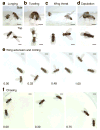Automated monitoring and analysis of social behavior in Drosophila
- PMID: 19270697
- PMCID: PMC2679418
- DOI: 10.1038/nmeth.1310
Automated monitoring and analysis of social behavior in Drosophila
Abstract
We introduce a method based on machine vision for automatically measuring aggression and courtship in Drosophila melanogaster. The genetic and neural circuit bases of these innate social behaviors are poorly understood. High-throughput behavioral screening in this genetically tractable model organism is a potentially powerful approach, but it is currently very laborious. Our system monitors interacting pairs of flies and computes their location, orientation and wing posture. These features are used for detecting behaviors exhibited during aggression and courtship. Among these, wing threat, lunging and tussling are specific to aggression; circling, wing extension (courtship 'song') and copulation are specific to courtship; locomotion and chasing are common to both. Ethograms may be constructed automatically from these measurements, saving considerable time and effort. This technology should enable large-scale screens for genes and neural circuits controlling courtship and aggression.
Figures





Comment in
-
The ethomics era?Nat Methods. 2009 Jun;6(6):413-4. doi: 10.1038/nmeth0609-413. Nat Methods. 2009. PMID: 19478800 No abstract available.
References
-
- Manoli DS, Foss M, Villella A, Taylor BJ, Hall JC, Baker BS. Male-specific fruitless specifies the neural substrates of Drosophila courtship behaviour. Nature. 2005;436:395–400. - PubMed
-
- Demir E, Dickson BJ. fruitless splicing specifies male courtship behavior in Drosophila. Cell. 2005;121:785–794. - PubMed
-
- Stockinger P, Kvitsiani D, Rotkopf S, Tirian L, Dickson BJ. Neural circuitry that governs Drosophila male courtship behavior. Cell. 2005;121:795–807. - PubMed
-
- Vrontou E, Nilsen SP, Demir E, Kravitz EA, Dickson BJ. fruitless regulates aggression and dominance in Drosophila. Nat Neurosci. 2006;9:1469–1471. - PubMed
-
- Manoli DS, Meissner GW, Baker BS. Blueprints for behavior: genetic specification of neural circuitry for innate behaviors. Trends Neurosci. 2006;29:444–451. - PubMed
Publication types
MeSH terms
Grants and funding
LinkOut - more resources
Full Text Sources
Other Literature Sources
Molecular Biology Databases

